Spatial Data Sharing: A Pilot Study of French SDIs
Abstract
:1. Introduction
2. Scope and Material
2.1. Material
2.2. Methods
2.2.1. Acquisition of Four Types of Data
2.2.2. Data Analysis
3. Results
3.1. Data Accessibility
3.1.1. What Do SDI Promoters Say about Data Accessibility?
3.1.2. Are the Data in SDIs Downloadable?
3.1.3. Are the Data Published in SDIs Easily Reusable?
3.2. Tool Interoperability
3.2.1. What Do SDI Promoters Say about Interoperability?
3.2.2. Are SDIs Interconnected to Accelerate Data Flows?
- Effects of scale are very marked in the centre-periphery structure of the graph. Most national SDIs are in the centre and the first outer circle gives a panorama of regional SDIs.
- Some infrastructures that make little use of harvesting techniques (small nodes) are centrally located as they are frequently harvested. This is the case of EauFrance and Geo-IDE.
- Theme-based network components may also be highlighted, for example, by connecting SDIs on maritime or coastal themes and in French overseas regions (Sextant—GeoMartinique or PEIGEO link).
3.3. Actor Networking
3.3.1. What Do the SDI Promoters Say about Geocollaboration Dynamics?
3.3.2. Do SDIs Promote Geocollaboration Dynamics?
3.3.3. Do SDIs Facilitate Networking among Diverse Actors?
3.4. Informational Equality of Territories
3.4.1. What Do SDI Promoters Say about Informational Equality of Territories?
3.4.2. Do SDIs Provide Homogeneous Coverage of Their Territories?
4. Discussion
5. Conclusions and Future Prospects
Supplementary Materials
Acknowledgments
Author Contributions
Conflicts of Interest
Appendix A. CSW-Harvester
Appendix A.1. Synopsis
Appendix A.2. Motivation
Appendix A.3. Dependencies
- psycopg2: PostgreSQL database adapter for Python, https://pypi.python.org/pypi/psycopg2
- OWSlib: Python package for client programming with Open Geospatial Consortium (OGC) web service (hence OWS) interface standards, https://github.com/geopython/OWSLib
- OWSlib requires elementtree (standard in 2.5 as xml.etree) or lxml
- PostgreSQL
Appendix A.4. How to Run
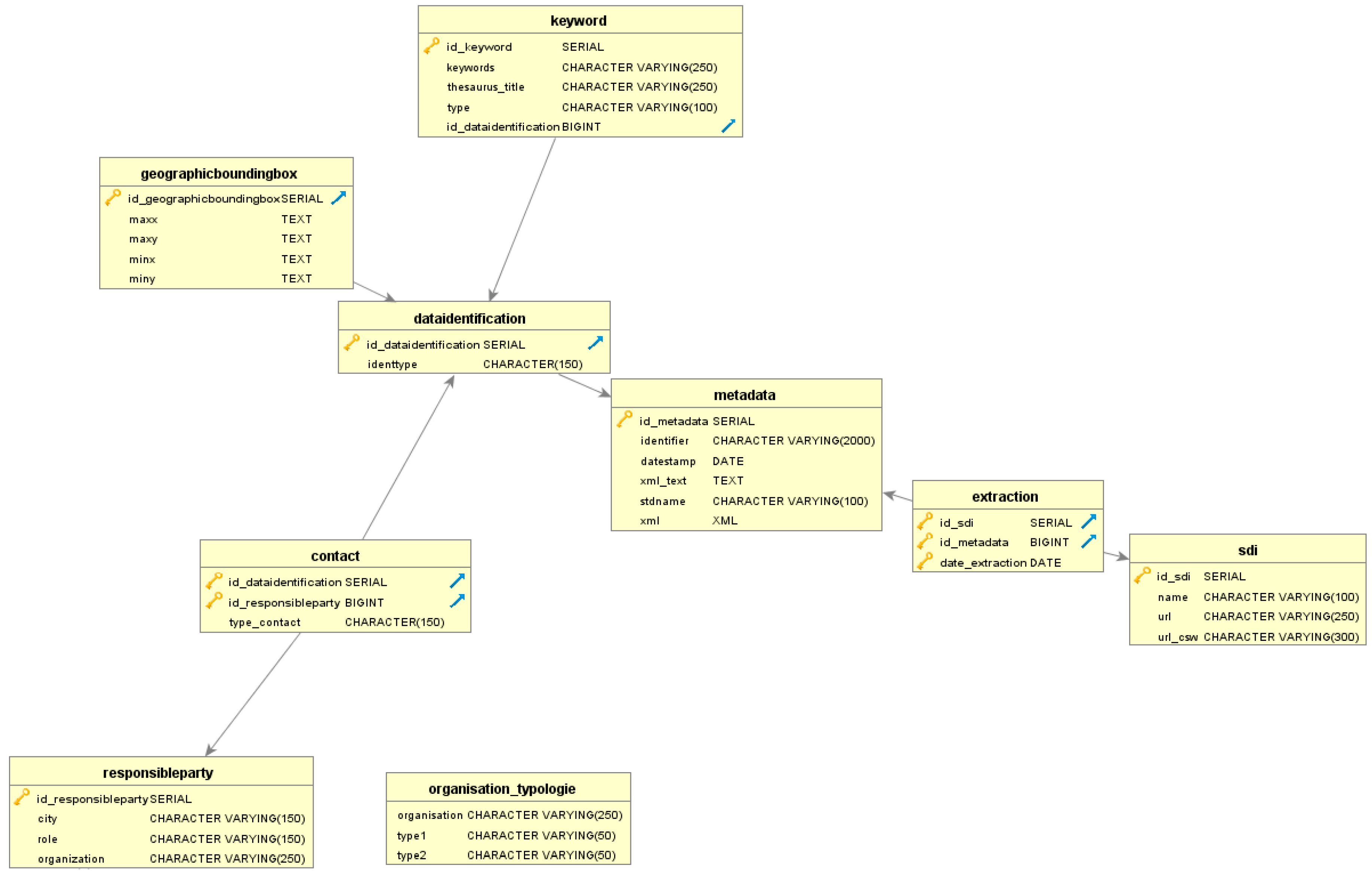
- -f OUTPUTSCHEMA, --outputschema=OUTPUTSCHEMA outputschema: default = http://www.isotc211.org/2005/gmd
- -s SOURCES, --sources=SOURCES CSV file, 7 fields separated by a comma: num_idg, name_idg, begin_record, end_record, MAXR, url, url_idg
- -l LOG_FILE, --log-file=LOG_FILE LOG file
- -c, --completion completion mode
- -d DATE, --date=DATE Extraction date
Appendix A.5. License
Appendix A.6. URL
Appendix B. Medata-Extents
Appendix B.1. Synopsis

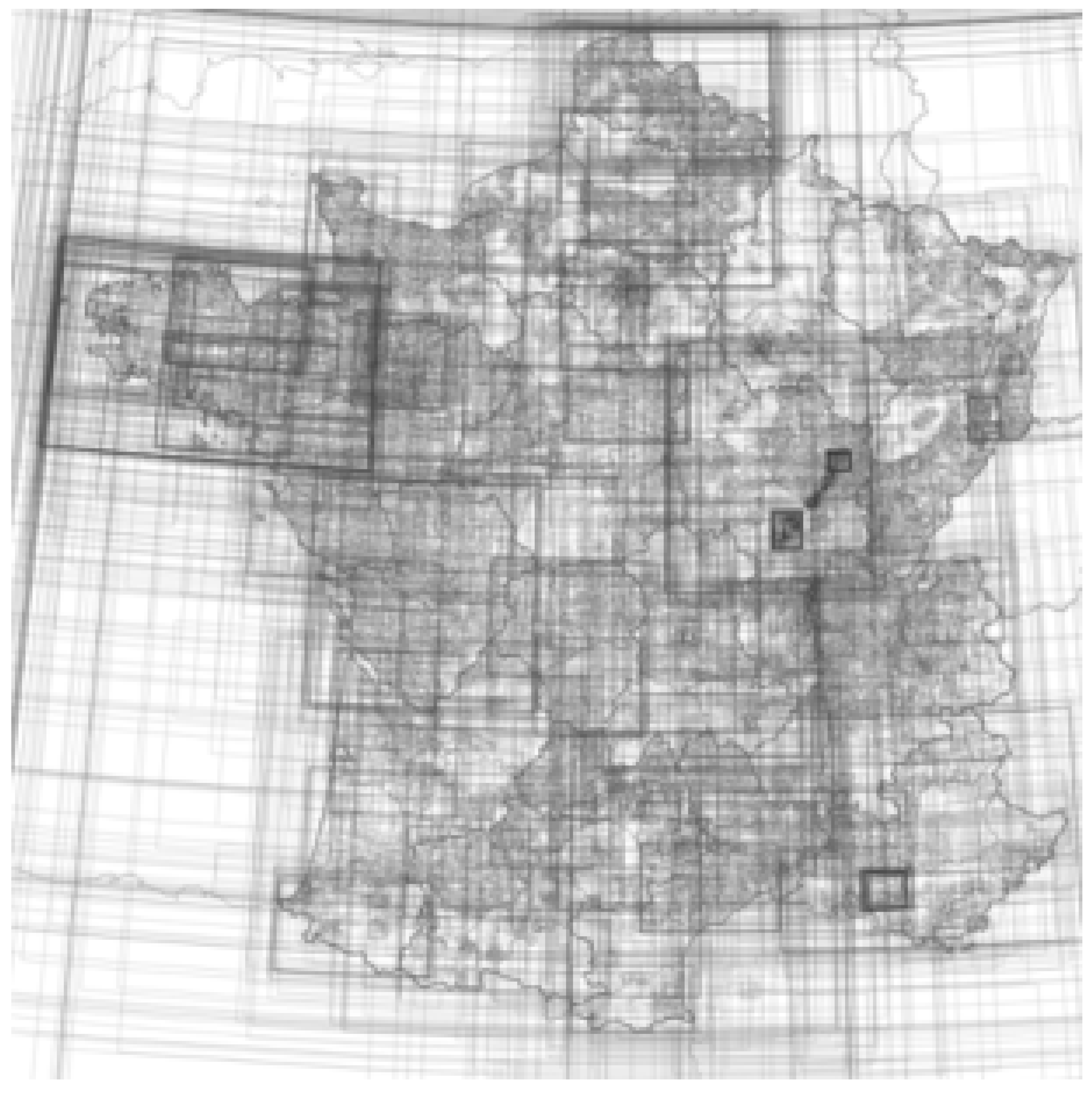
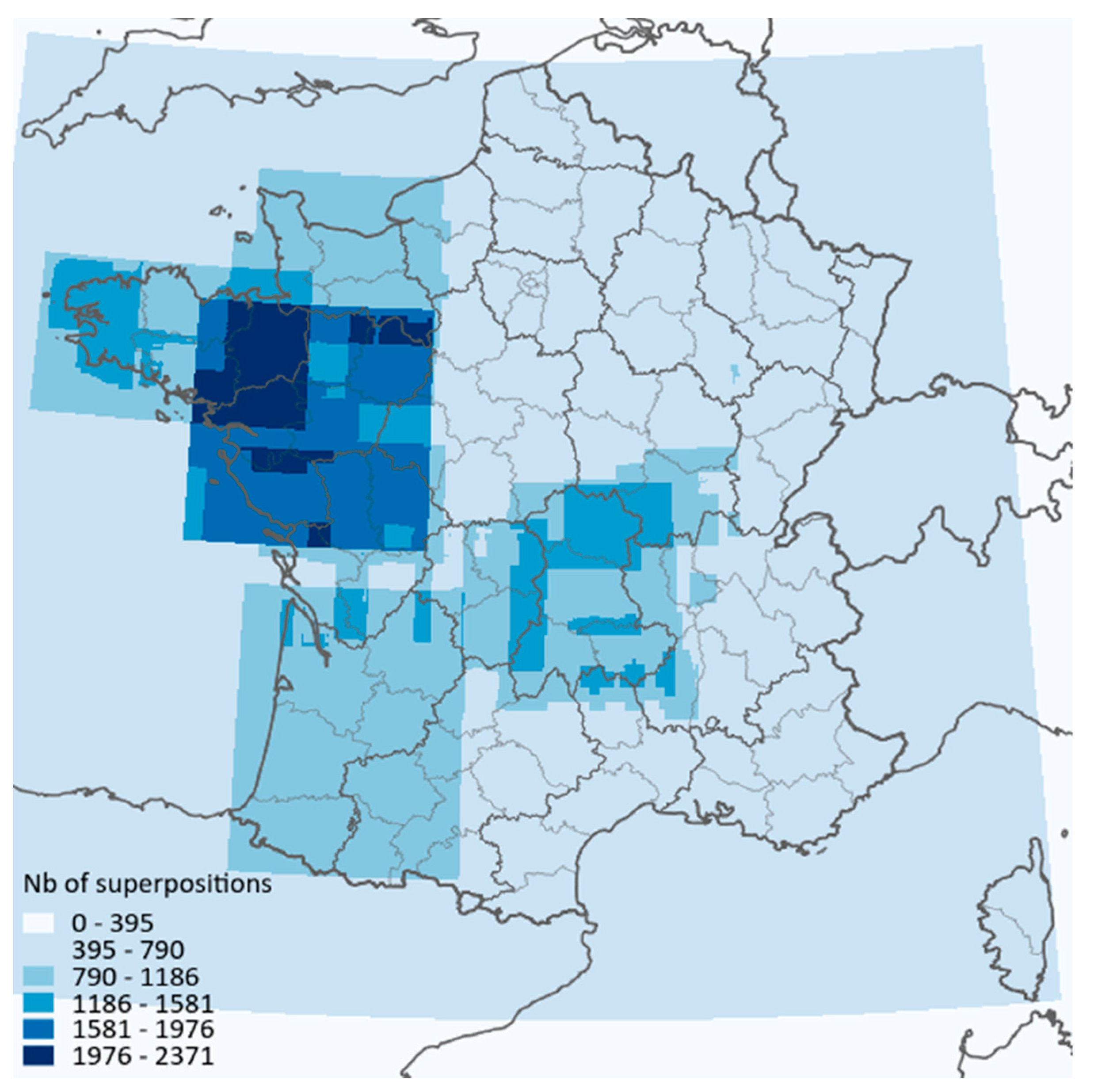
Appendix B.2. Motivation
Appendix B.3. Dependencies
- numpy: package for scientific computing with Python, http://www.numpy.org/
- pandas: Python data analysis library, http://pandas.pydata.org/
Appendix B.4. How to Run
- resolution (same unit as coordinates used in CSV, i.e., degrees if coordinates in WGS84)
- path to CSV
- delimiter of CSV
- quotechar of CSV
- names of CSV columns
- name of output raster to be created
- name of log file
Appendix B.5. License
Appendix B.6. URL
References
- Craglia, M.; de Bie, K.; Jackson, D.; Pesaresi, M.; Remetey-Fülöpp, G.; Wang, C.; Annoni, A.; Bian, L.; Campbell, F.; Ehlers, M.; et al. Digital Earth 2020: Towards the vision for the next decade. Int. J. Dig. Earth 2012, 5, 4–21. [Google Scholar] [CrossRef]
- Rajabifard, A.; Feeney, M.-E.; Williamson, I.; Masser, I. Chapter 6, National SDI Initiatives. In Development of Spatial Data Infrastructures: From Concept to Reality; Williamson, I., Rajabifard, A., Feeney, M.-E.F., Eds.; Taylor & Francis: London, UK, 2003; pp. 95–109. [Google Scholar]
- Crompvoets, J.; Bregt, A.; Rajabifard, A.; Williamson, I. Assessing the world wide developments of national spatial data clearinghouses. Int. J. Geogr. Inf. Sci. 2004, 18, 665–689. [Google Scholar] [CrossRef]
- Masser, I. Building European Spatial Data Infrastructures; ESRI Press: Redlands, CA, USA, 2010. [Google Scholar]
- Gautreau, P.; Noucher, M. Sharing Platform in Digital Geographic Information: Everything It Promise? Justice Spat./Spat. Justice 2016, 10. Available online: http://www.jssj.org/ (accessed on 27 March 2017).
- Mol, A.P.J. Environmental governance through information: China and Vietnam. Singap. J. Trop. Geogr. 2009, 30, 114–129. [Google Scholar] [CrossRef]
- Kooper, M.N.; Maes, R.; Lindgreen, E.R. On the governance of information: Introducing a new concept of governance to support the management of information. Int. J. Inf. Manag. 2011, 31, 195–200. [Google Scholar] [CrossRef]
- Mol, A. Environmental Reform in the Information Age. The Contours of Informational Governance; Cambridge University Press: Cambridge, UK, 2008. [Google Scholar]
- Hendriks, P.H.J.; Dessers, E.; Van Hootegen, G. Reconsidering the definition of spatial data infrastructure. Int. J. Geogr. Inf. Sci. 2012, 26, 1479–1494. [Google Scholar] [CrossRef]
- Coetzee, S.; Wolff-Piggott, B. A Review of SDI Literature: Searching for Signs of Inverse Infrastructures. Cartography—Maps Connecting the World. In Part of the series Lecture Notes in Geoinformation and Cartography; Springer International Publishing: Zurich, Switzerland, 2015; pp. 113–127. [Google Scholar]
- Percivall, G. The application of open standards to enhance the interoperability of geoscience information. Int. J. Dig. Earth 2010, 3, 14–30. [Google Scholar] [CrossRef]
- Genovese, E.; Cotteret, G.; Roche, S.; Caron, C. Evaluating the socio-economic impact of geographic information: A classification of the literature. Int. J. Spat. Data Infrastruct. Res. 2009, 4, 218–238. [Google Scholar]
- Reznik, T.; Chudy, R.; Micietova, E. Normalized evaluation of the performance capacity and availability of catalogue services: A pilot study based on Infrastructure for Spatial Information in Europe. Int. J. Dig. Earth 2016, 9, 325–341. [Google Scholar] [CrossRef]
- Ballatore, A. Exploring the geographic information universe: The role of search technologies. In Proceedings of the Workshop on Geographic Information Observatories at GIScience, Vienna, Austria, 23–26 September 2014. [Google Scholar]
- Kitchin, R.; Lauriault, T. Towards Critical Data Studies: Charting and Unpacking Data Assemblages and Their Work. In Geoweb and Big Data; Eckert, J., Shears, A., Thatcher, J., Eds.; University of Nebraska Press: Lincoln, NE, USA; Available online: http://papers.ssrn.com/sol3/papers.cfm?abstract_id=2474112 (accessed on 27 March 2017).
- Ladurelle-Tikry, E.; Debord, M. French regional SDI Network: Parternship for sharing Inspire experience. In Proceedings of the INSPIRE Conference, Istanbul, Turkey, 23–27 June 2012. [Google Scholar]
- Noucher, M.; Gourmelon, F.; Georis-Creuseveau, J. Toward an Observatory Prototype of the Contents of the 65 french SDIs. In Proceedings of the Inspire Conference—Geospatial World Forum, Lisbon, Portugal, 25–29 May 2015. [Google Scholar]
- Johnson, R.B.; Onwuegbuzie, A.J. Mixed Methods Research: A Research Paradigm whose Time Has Come. Educ. Res. 2004, 33, 14–26. [Google Scholar] [CrossRef]
- Devillers, R.; Jeansoulin, R. Fundamentals of Spatial Data Quality; ISTE Publishing Company: Eugene, OR, USA, 2006; p. 312. [Google Scholar]
- Wenger, E. Communities of Practice: Learning, Meaning, and Identity; Cambridge University Press: Cambridge, UK, 1998. [Google Scholar]
- Rix, J.; Fast, S.; Masser, I.; Salgé, F.; Vico, F. Methodology to Describe, Analyse and Assess Subnational SDIs: Survey, Experiences and Lessons Learnt. Int. J. Spat. Data Infrastruct. Res. 2011, 6, 23–52. [Google Scholar]
- Salgé, F.; Ladurelle-Tikry, E.; Fourcin, L.; Dewynter, B. Review of sub-National SDIs in France An outcome of the eSDI-Net+ project. In Proceedings of the GSDI Conference, Rotterdam, The Netherlands, 15–19 June 2009. [Google Scholar]
- Craglia, M.; Roglia, E.; Tomas, R. INSPIRE Public Consultation 2014, Reports on Findings. Technical Report by the Joint Research Centre of the European Commission. 2014. Available online: http://inspire.ec.europa.eu/reports/consultations/INSPIRE_Public_Consultation_Report_final.pdf (accessed on 27 March 2017).
- European Environment Agency. Mid-Term Evaluation Report on INSPIRE Implementation. EEA Technical report No 17/2014. 2014. Available online: http://www.eea.europa.eu/publications/midterm-evaluation-report-on-inspire-implementation (accessed on 27 March 2017).
- Balram, S.; Dragicevic, S. Geocollaboration. In Encyclopedia of GIS; Shekhar, S., Xiong, H., Eds.; Springer: New York, NY, USA, 2008; pp. 344–347. [Google Scholar]
- Chang, Z.; Li, S. Geo-social model a conceptual framework for real-time geocollaboration. Trans. GIS 2013, 17, 182–205. [Google Scholar] [CrossRef]
- Sun, Y.; Li, S. Real-time collaborative GIS: A technological review. ISPRS J. Photogramm. Remote Sens. 2016, 115, 143–152. [Google Scholar] [CrossRef]
- United Nations Economic Commission for Europe, Convention on Access to Information, Public Participation in Decision-Making and Access to Justice in Environmental Matters. 1998. Available online: http://www.unece.org/fileadmin/DAM/env/pp/documents/cep43e.pdf (accessed on 27 March 2017).
- Georis-Creuseveau, J.; Claramunt, C.; Gourmelon, F. A modelling framework for the study of Spatial Data Infrastructures applied to coastal management and planning. Int. J. Geogr. Inf. Sci. 2017, 37, 122–138. [Google Scholar] [CrossRef]
- Venkatesh, V.; Morris, M.G.; Davis, G.B.; David, F.D. User acceptance of information technology: Toward a unified view. MIS Q. 2003, 27, 425–478. [Google Scholar]


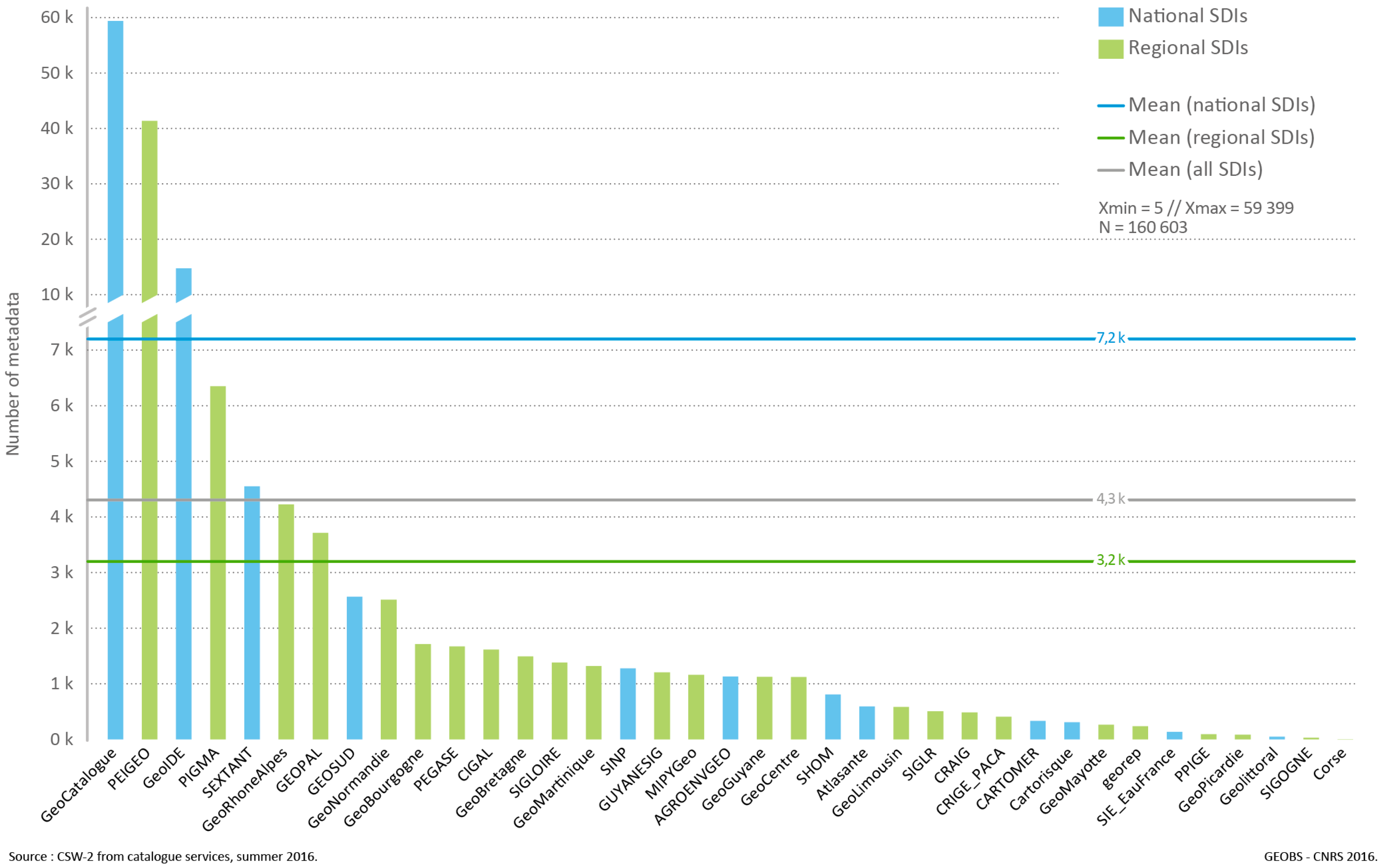
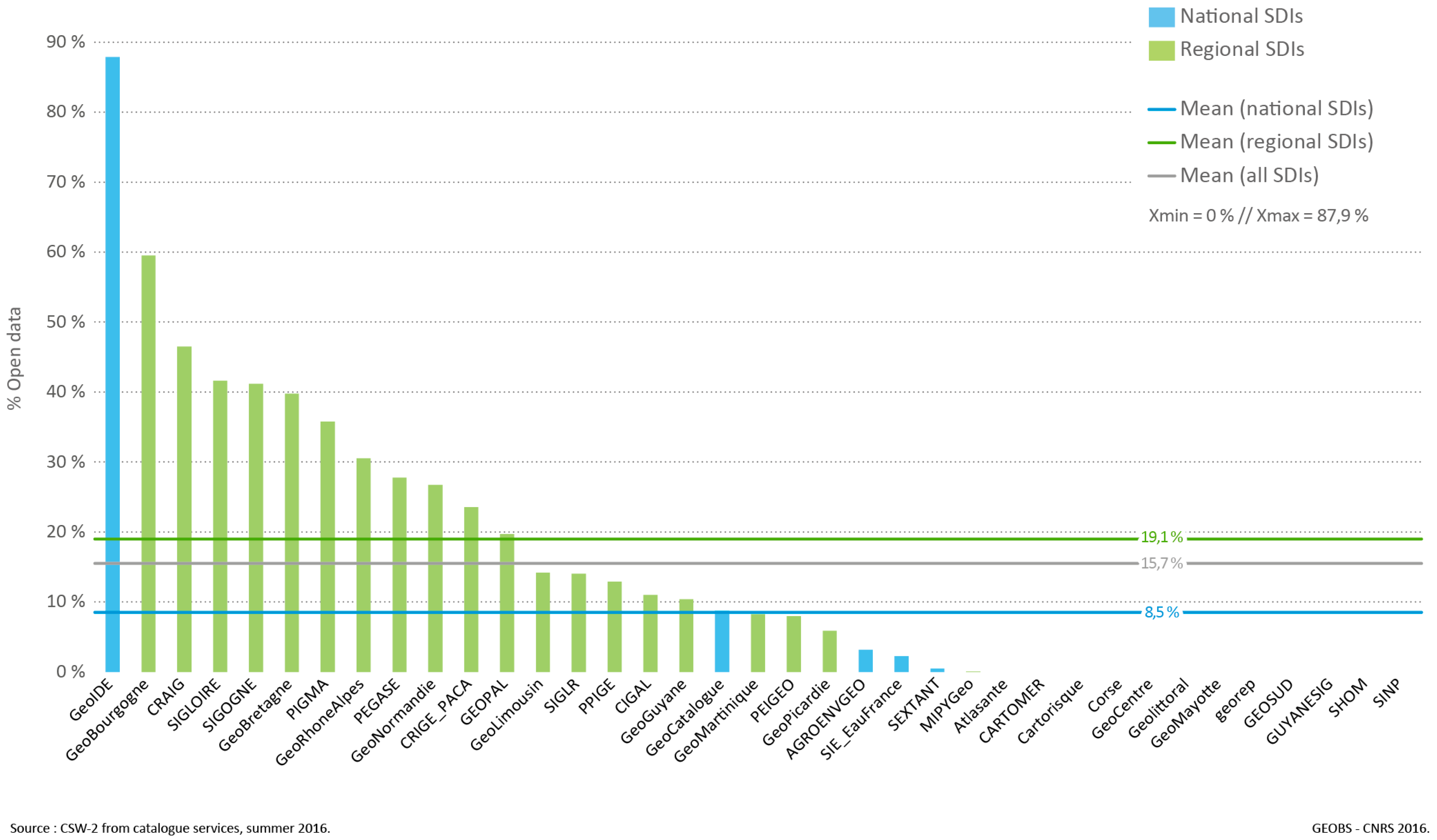
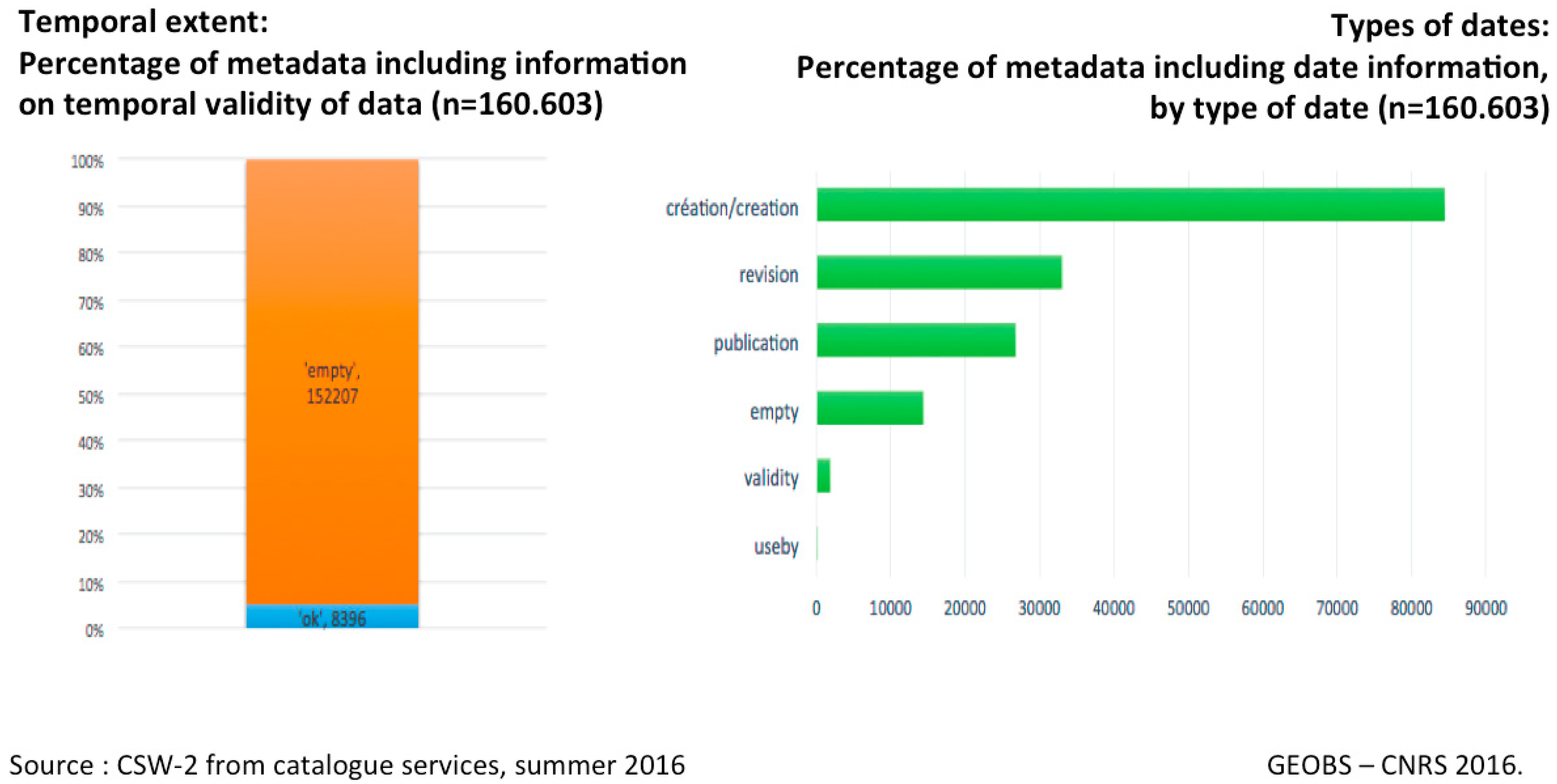
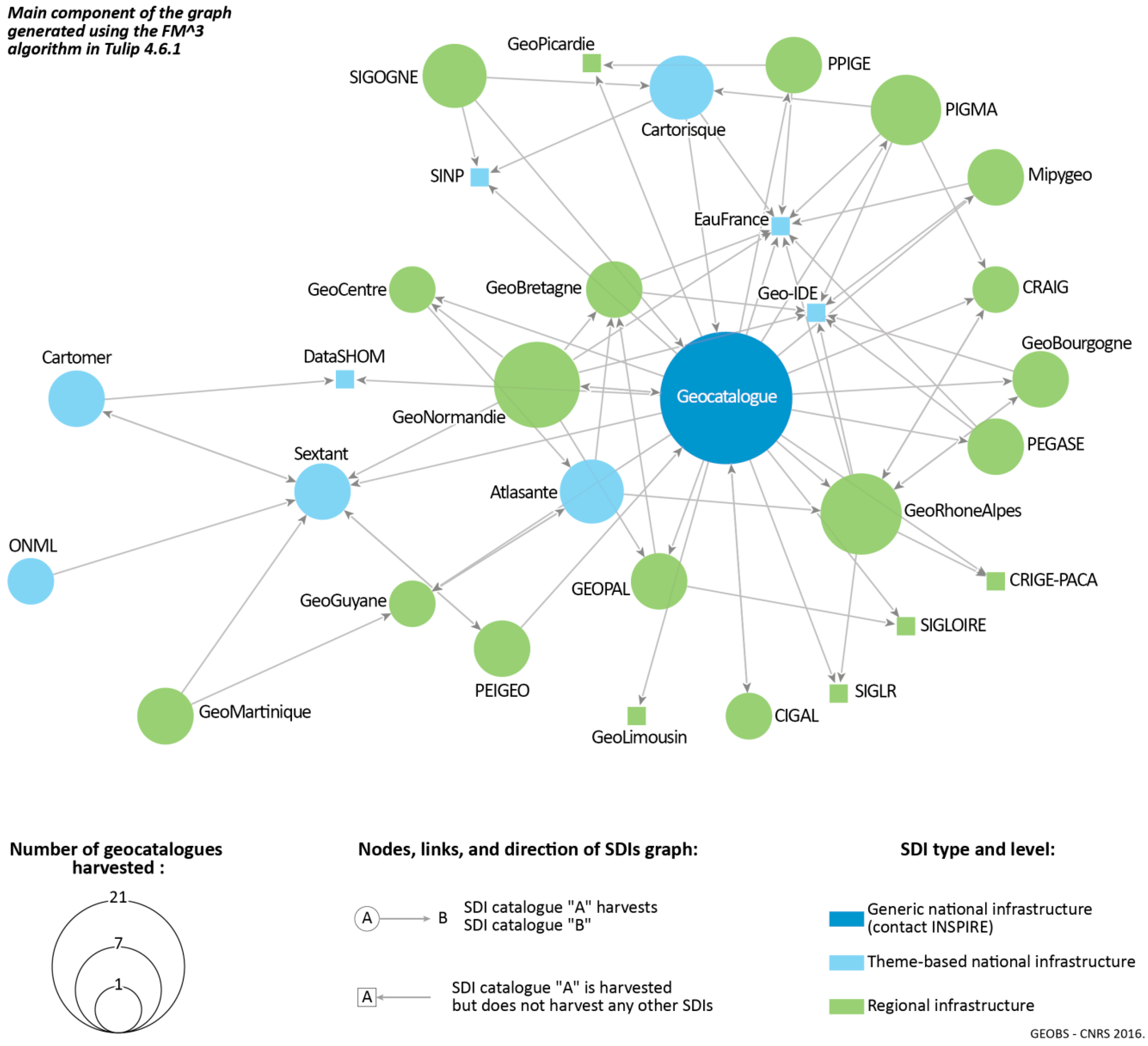
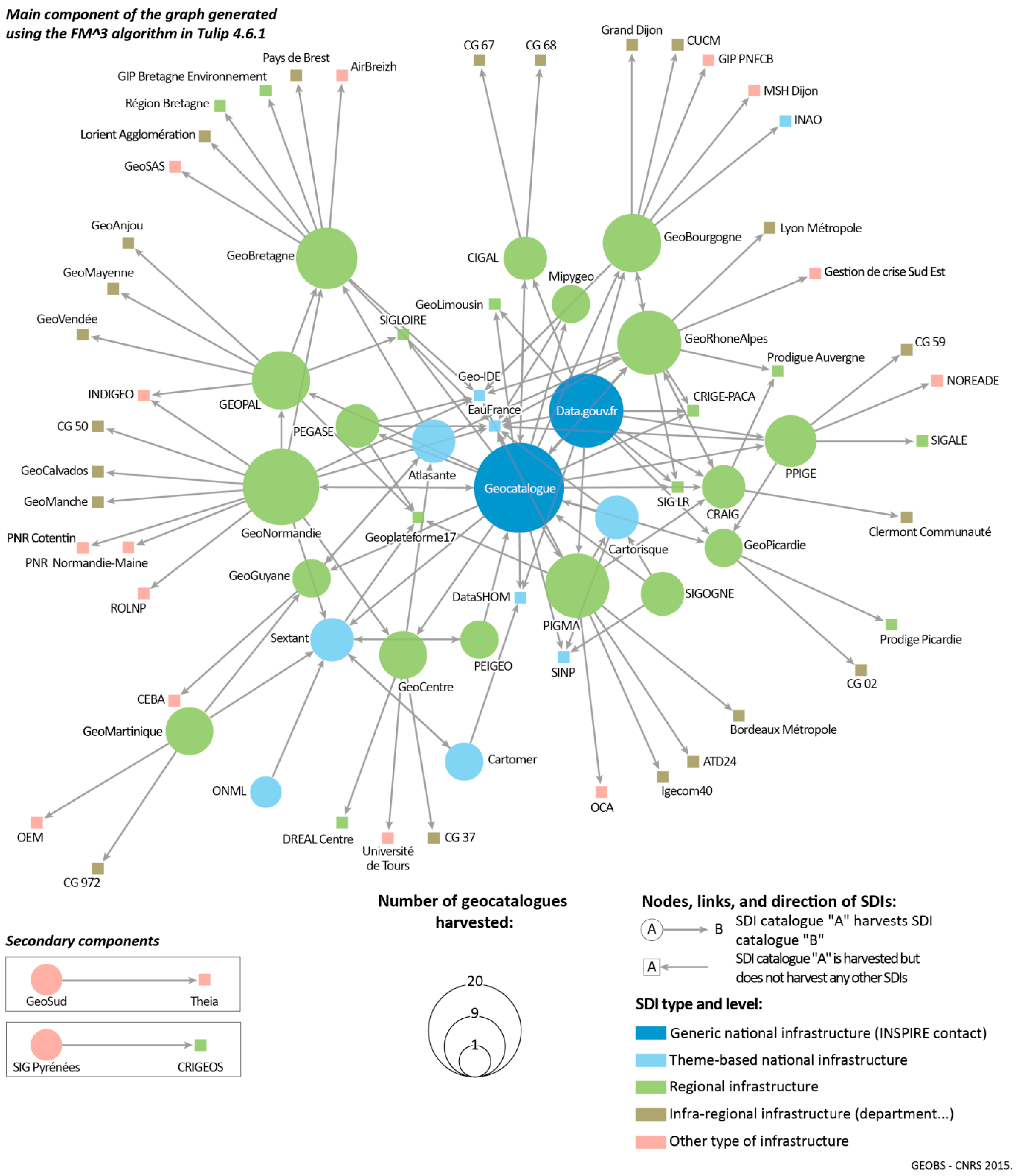
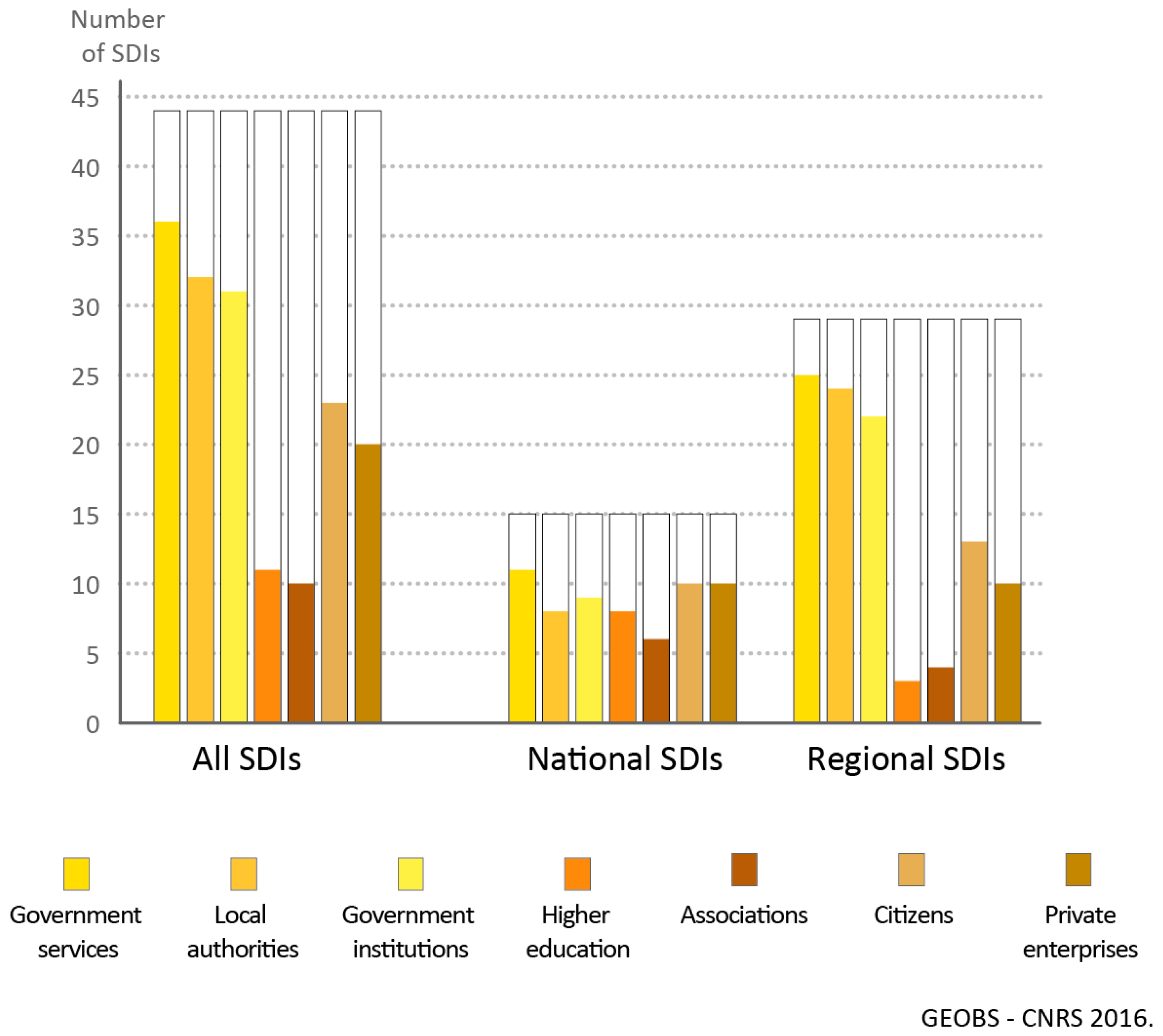
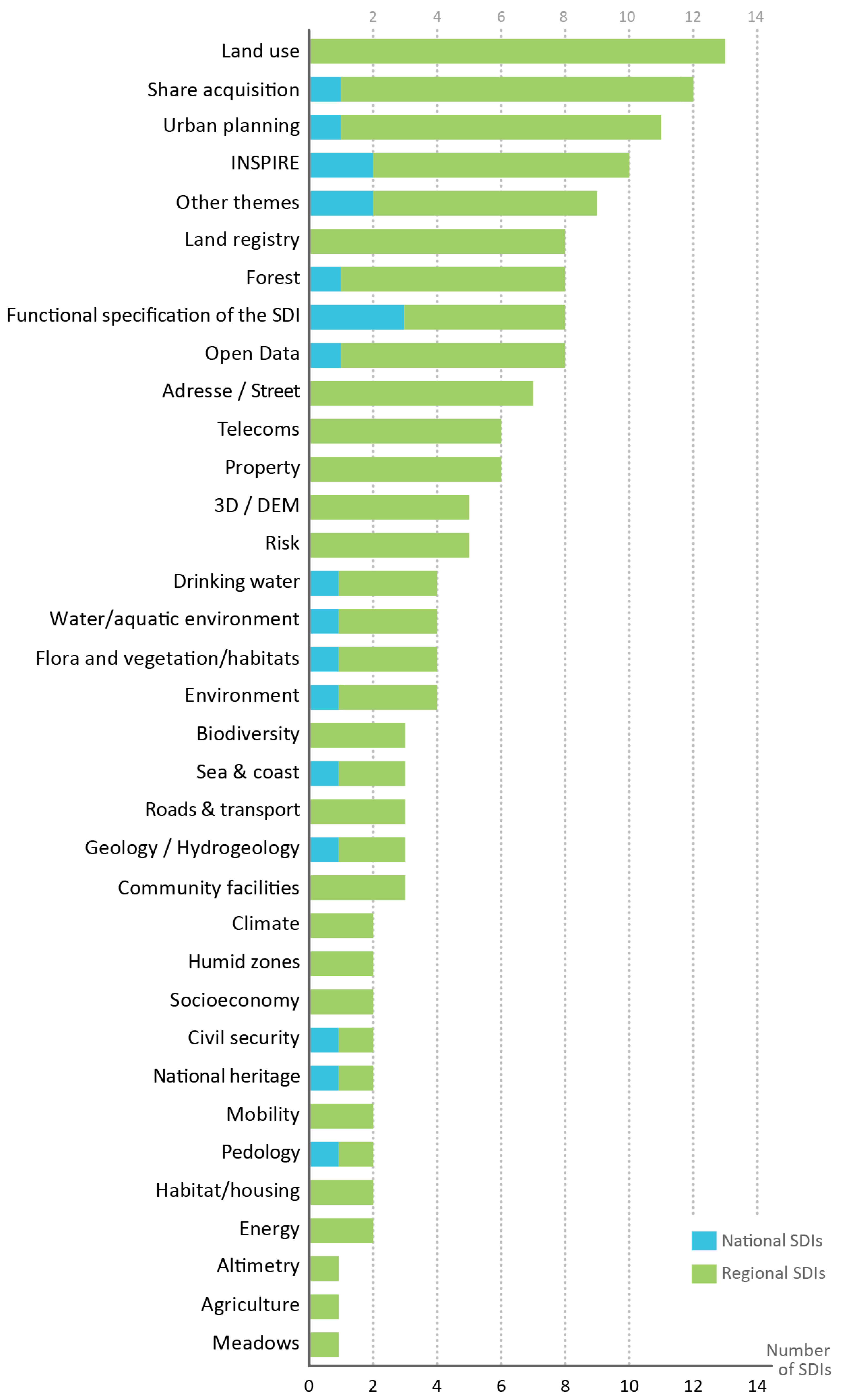
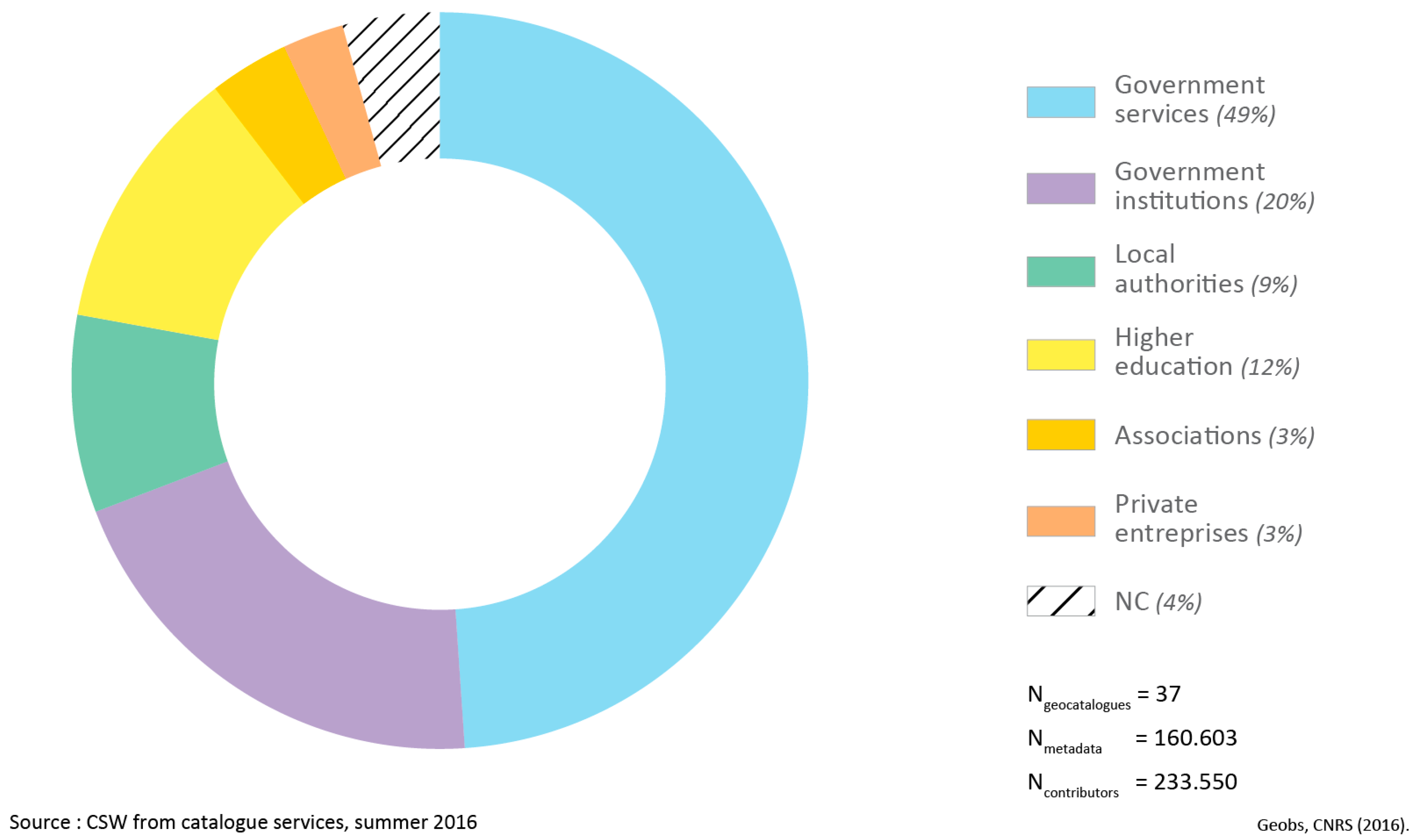
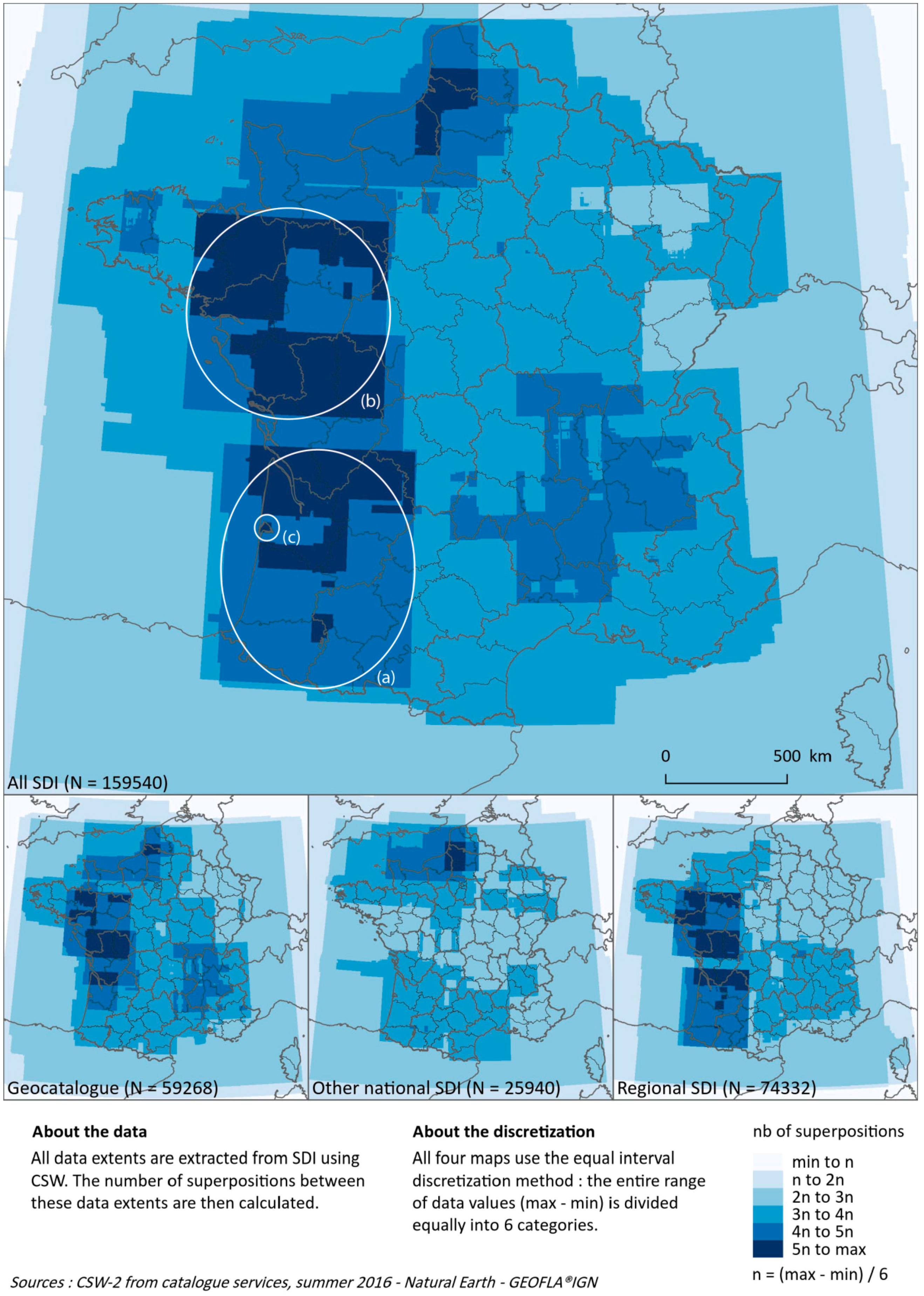
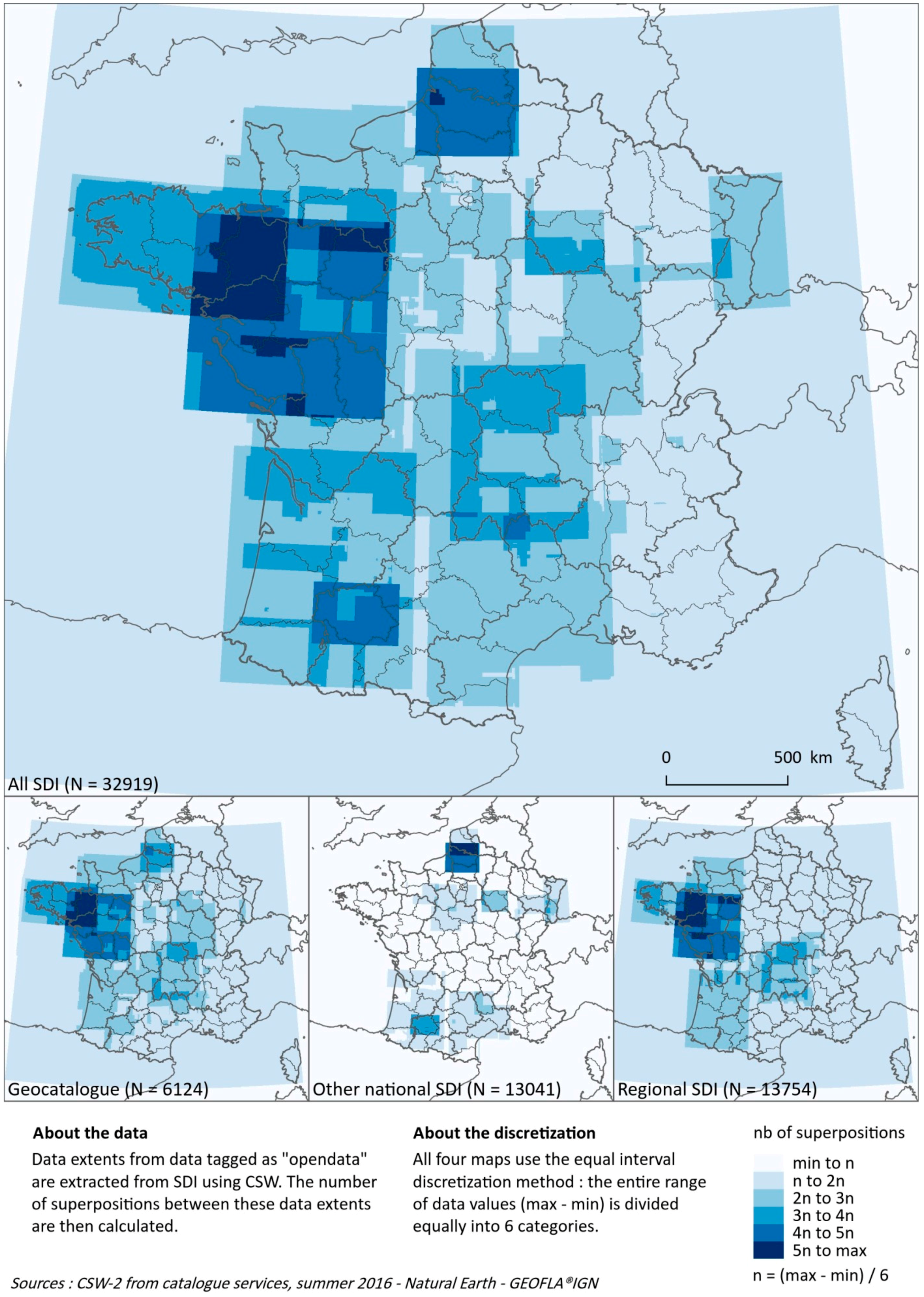
| Data Sharing Component | Research Question | Source |
|---|---|---|
| A. Data accessibility | A1. What do SDI promoters say about data accessibility? | Website and interviews |
| A2. Are the reference data in SDIs downloadable? | Metadata catalogues | |
| A3. Are the data published in SDIs easily reusable? | Metadata catalogues | |
| B. Tool interoperability | B1. What do SDI promoters say about interoperability? | Website and interviews |
| B2. Are SDIs interconnected to accelerate data flows? | Survey | |
| C. Actor networking | C1. What do the SDI promoters say about geocollaboration dynamics? | Website and interviews |
| C2. Do SDIs promote geocollaboration dynamics? | Survey | |
| C3. Do SDIs facilitate the networking of diverse actors? | Metadata catalogues | |
| D. Informational equality of territories | D1. What do SDI promoters say about informational equality? | Website and interviews |
| D2. Do SDIs provide homogeneous coverage of their territories? | Metadata catalogues |
© 2017 by the authors. Licensee MDPI, Basel, Switzerland. This article is an open access article distributed under the terms and conditions of the Creative Commons Attribution (CC BY) license (http://creativecommons.org/licenses/by/4.0/).
Share and Cite
Noucher, M.; Gourmelon, F.; Gautreau, P.; Georis-Creuseveau, J.; Maulpoix, A.; Pierson, J.; Pinède, N.; Pissoat, O.; Rouan, M. Spatial Data Sharing: A Pilot Study of French SDIs. ISPRS Int. J. Geo-Inf. 2017, 6, 99. https://doi.org/10.3390/ijgi6040099
Noucher M, Gourmelon F, Gautreau P, Georis-Creuseveau J, Maulpoix A, Pierson J, Pinède N, Pissoat O, Rouan M. Spatial Data Sharing: A Pilot Study of French SDIs. ISPRS International Journal of Geo-Information. 2017; 6(4):99. https://doi.org/10.3390/ijgi6040099
Chicago/Turabian StyleNoucher, Matthieu, Françoise Gourmelon, Pierre Gautreau, Jade Georis-Creuseveau, Adeline Maulpoix, Julie Pierson, Nathalie Pinède, Olivier Pissoat, and Mathias Rouan. 2017. "Spatial Data Sharing: A Pilot Study of French SDIs" ISPRS International Journal of Geo-Information 6, no. 4: 99. https://doi.org/10.3390/ijgi6040099
APA StyleNoucher, M., Gourmelon, F., Gautreau, P., Georis-Creuseveau, J., Maulpoix, A., Pierson, J., Pinède, N., Pissoat, O., & Rouan, M. (2017). Spatial Data Sharing: A Pilot Study of French SDIs. ISPRS International Journal of Geo-Information, 6(4), 99. https://doi.org/10.3390/ijgi6040099






